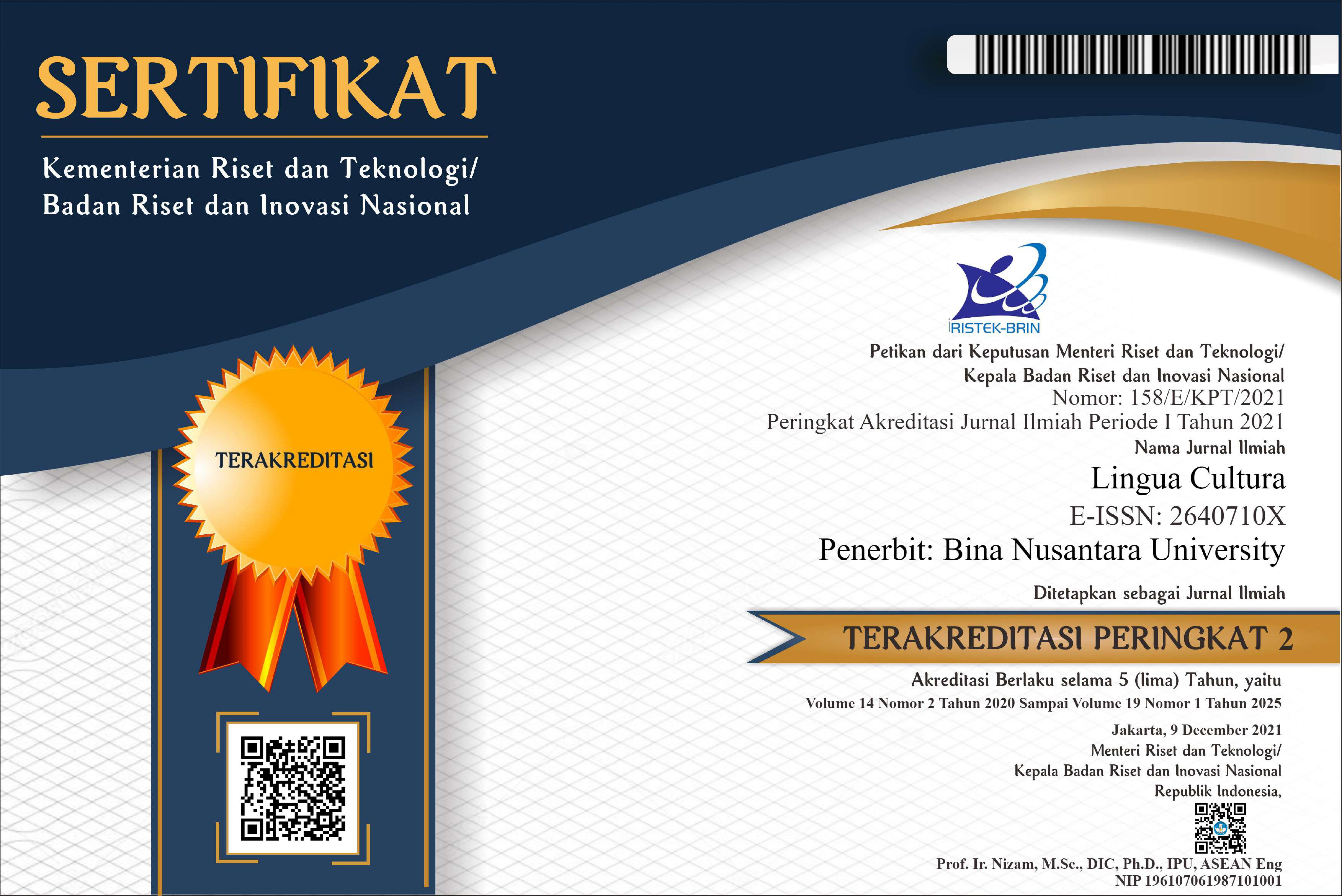Gender Differences In Giving Directions: A Case Study Of English Literature Students At Binus University
DOI:
https://doi.org/10.21512/lc.v5i1.372Keywords:
sociolinguistics, gender, cognitive, spatial ability, giving directionsAbstract
Many researchers have said that there are differences in the ways people give direction between males and females, especially in spatial task (cardinal directions, topography, mileage, building, right/left markers) (e.g., Lawton, 2001; Dabbs et al., 1998). Here, the thesis investigates what differences occur between both genders in giving direction. The respondents are 25 females and 25 males of fifth semester Binus University students majoring in English Literature. The respondents answered with a certain route from Binus’s Anggrek Campus to Senayan City. The study was conducted by qualitative and quantitative method. From the data analysis, the writer discovered that gender does affect in selecting the key words in explaining direction it is found that there were differences in choosing key words in giving direction between females and males. The difference is women use more than twice spatial references than men do. In terms of verbal abilities, it was confirmed that female use longer explanation. However, in other aspects such as serial orientation and maintenance words, the result is inconclusive.
Plum Analytics
References
Boerger, M.A., & Henley, T.B. (1999). The usage of analogy in giving instructions. The Psychological Record, 49, 193-209. In Napoleon, S. (2007). From here to there: A sociolinguistics study in gender and direction-giving. Indiana Undergraduate Journal of Cognitive Science, 2, 18-2
Cohen, A.A. (1997). The communicative functions of hand illustrators. Journal of Communication, 27, 54-63. In Napoleon, S. (2007). From here to there: A sociolinguistics study in gender and direction-giving. Indiana Undergraduate Journal of Cognitive Science, 2, 18-2
Dabbs, J. M., Jr., Chang, E., Strong, R. A., & Milun, R. (1998). Spatial ability, navigation strategy, and geographic knowledge among men and women. Human Behavior and Evolution, 19, 89-98. In Lawton, C.A. (2001). Gender and regional differences in spatial referents used in direction giving. Sex Roles, 44, 321–337
Gray, J. (2005). Men are from mars women from venus. (T. Hermaya, Trans). Jakarta: P.T Gramedia Pustaka Utama
Kleinedler, S. et al. (2005). The American heritage science dictionary. USA: Houghton Mifflin
Lawton, C.A. (2001). Gender and regional differences in spatial referents used in direction giving. Sex Roles, 44, 321–337
Maccoby, E. E., and Jacklin, C. N. (1974) The Psychology of Sex Differences Stanford, CA: Stanford University.
Montello, D. R., Lovelace, K. L., Golledge R. G.,Self, C. M. (1999) Sex-related differences and similarities in geographical and environmental spatial abilities. Annals of the Association of American Geographers, 89(3), p.515-534.
Napoleon, S. (2007). From here to there: A sociolinguistics study in gender and direction-giving. Indiana Undergraduate Journal of Cognitive Science, 2, 18-2
Plumert, T. et al. (2005). Gender differences and cognition among older adults. Aging, Neuropsychology, and Cognition, 12, 77-88. In Napoleon, S. (2007). From here to there: A sociolinguistics study in gender and direction-giving. Indiana Undergraduate Journal of Cognitive Science, 2, 18-2
Downloads
Published
Issue
Section
License
Authors who publish with this journal agree to the following terms:
a. Authors retain copyright and grant the journal right of first publication with the work simultaneously licensed under a Creative Commons Attribution License - Share Alike that allows others to share the work with an acknowledgment of the work's authorship and initial publication in this journal.
b. Authors are able to enter into separate, additional contractual arrangements for the non-exclusive distribution of the journal's published version of the work (e.g., post it to an institutional repository or publish it in a book), with an acknowledgment of its initial publication in this journal.
c. Authors are permitted and encouraged to post their work online (e.g., in institutional repositories or on their website) prior to and during the submission process, as it can lead to productive exchanges, as well as earlier and greater citation of published work.
USER RIGHTS
All articles published Open Access will be immediately and permanently free for everyone to read and download. We are continuously working with our author communities to select the best choice of license options, currently being defined for this journal as follows: Creative Commons Attribution-Share Alike (CC BY-SA)

















